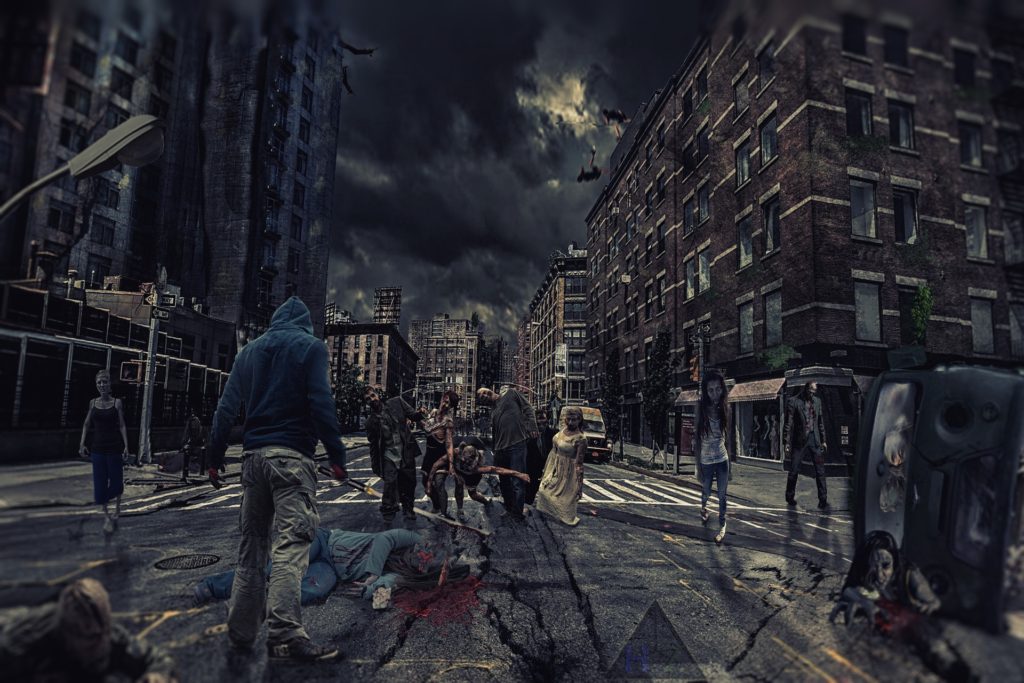December 17, 2017
Zombies and Dehumanization
The ideas explicated in the following text might to an extent be embarrassingly obvious to many fans of zombie narratives or experienced literature students and academics. But allow me to speculate that there is a significant number of people who have not considered these ideas. It is for their benefit I offer the following short analysis of what zombies can stand for.

Zombies of Literature…
One of the things that attract me in Gothic literature is the ability with which such narratives can deploy symbolism. Furthermore, Gothic narratives are remarkably flexible, transcending boundaries of space and time – if you haven’t done so, take a look at my article on Gothic doubles and… Facebook. The zombie figure began its narrative journey more or less from the interwar period. Crucially, however, it was still nothing more than an individual. Not unlike previous horror narratives, we have a single creature (or a small number of them) threatening a limited, finite number of people. Things changed, radically, with Romero’s 1968 Night of the Living Dead. Suddenly, zombies were a mass. More still, the idea of contagion began to find its way into the viewers’ subconscious.
Fast-forward a few decades, in our post-9/11 era
…and how the metaphor works
Let’s take a look at the zombie phenomenon today, making a checklist of sorts:
- Zombies are never individuals. They are masses, and they should be treated like masses.
- Their condition is contagious, they can alter us as well. Plus, zombies multiply at an alarming rate.
- You cannot help zombies, so you better stop thinking about it. They’re not humans.
- Besides, zombies don’t know what’s good for them. They have no feeling of self-preservation, they’ll just march to their own deaths.
- It took us centuries to build this civilization, and now zombies can destroy it in no time, if we’re not careful.
I could go on and on, but let’s stop here.
Do you begin to see it?
As I said, it can be embarrassingly obvious if you’re experienced in zombie horror narratives.
The Dehumanization Process
If you’re not sure what I’m talking about, simply exchange the word “zombies” with the word “immigrants” on the checklist above and see what happens. The zombie has been symbolically linked to immigration pretty comprehensively (other readings are related to working-class uprisings or consumerism, but we can leave that for another day).
The thoroughly disturbing aspect in all this is the concept of Dehumanization. If you’re interested, read Jonathan Glover’s Humanity: A Moral History of the 20th Century to see how it works. Basically, you convince a group of people – normal, everyday people like you and me – that another group of people are not really humans. Then, it becomes far easier to convince the first group to turn on the second. This is how the Holocaust happened, this is how Hiroshima happened, this is how My Lai, Bosnia, and Rwanda happened.
And this is what is happening now, with systemic backing. When you have a group of people who cannot and would not think critically, a loudmouth offering simplistic answers to complex questions will inevitably convince them that he is right. In turn, this facilitates the process of dehumanization.
Keep all these things in mind next time you see a zombie film.
Further Reading
If you’re interested in the topic of pairing Gothic narratives with social discourses related to ethnicity and class, you might wanna take a look at Franco Moretti’s Signs Taken for Wonders. Here’s a relevant excerpt:
The literature of terror is born precisely out of the terror of a split society and out of the desire to heal it. It is for just this reason that Dracula and Frankenstein, with rare exceptions, do not appear together. The threat would be too great, and this literature, having produced terror, must also erase it and restore peace. It must restore the broken equilibrium — giving the illusion of being able to stop history — because the monster expresses the anxiety that the future will be monstrous.
His antagonist — the enemy of the monster — will always be, by contrast, a representative of the present, a distillation of complacent nineteenth-century mediocrity: nationalistic, stupid, superstitious, philistine, impotent, self-satisfied. But this does not show through. Fascinated by the horror of the monster, the public accepts the vices of its destroyer without a murmur, just as it accepts his literary depiction, the jaded and repetitive typology which regains its strength and its virginity on contact with the unknown. The monster, then, serves to displace the antagonisms and horrors evidenced within society to outside society itself. In Frankenstein the struggle will be between a ‘race of devils’ and the ‘species of man’. Whoever dares to fight the monster automatically becomes the representative of the species, of the whole of society. The monster, the utterly unknown, serves to reconstruct a universality, a social cohesion which in itself would no longer carry conviction.
Comments are closed for posts older than 90 days